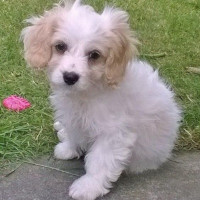Appearance of the Cav-A-Malt
|
| With a relatively domed head, circular brown eyes and silky, pendulous ears, the Cav-A-Malt is undeniably adorable. Their muzzle is quite short and they often have the loose upper lip of their Cavalier relative. Although quite small, their bone structure shouldn't be too delicate and their limbs have good muscle coverage. The Cav-A-Malt's tail is variable, some having the curved tail of the Maltese, while others have the curved, feathery tail of the Cavalier. The Cav-A-Malt's coat tends to be long and wavy, although many owners will opt for a shorter, curlier coat from a groomer. Black, bronze and white are the most common colors, but puppies can also have red fur, and it's not uncommon for a dog to be bicolor or tricolor. A small dog, most are between 25 and 35 cm when they reach maturity. Likewise, they rarely reach a weight of over 6.5 kg, with the smallest weighing around 4.5 kg. |
Temperament of the Cav-A-Malt
|
| The Cav-A-Malt is a lively, playful, fun-loving dog that often gets along very well with all kinds of people. These little hybrid dogs have moderate to low energy levels and are fairly easy to train, especially for novice owners. Consistency is essential, however, and repetition is sometimes necessary. They are friendly and curious when meeting strangers and children. However, this characteristic depends on the Cav-A-Malt's degree of socialization. Poor Cav-A-Malt training can lead to your dog displaying dominant behavior, such as lunging and protecting food and toys. When adopting a small dog, it's important to teach it how to behave - encouragement and positive reinforcement are very helpful. However, as with all dogs, it's just as important to teach children how to handle and approach them. Cav-A-Malt owners say they are a wonderful addition to the family, but they need a lot of attention and don't like to be left alone at home as they are prone to separation anxiety. |
Needs and activities of the Cav-A-Malt
|
| The Cav-A-Malt's size and activity level make it a good candidate for apartment accommodation. They don't require a lot of space and are content with a few short walks a day. They like to meet and greet in the neighborhood. It's a good activity for practicing the social skills acquired in obedience training. The Cav-A-Malt is also known for his talent in the agility circle, so give him a chance to show off his intelligence and eager personality. He'll also appreciate a home with a backyard. Be sure to accompany him outdoors, as he doesn't like to be left alone. |
Maintenance of the Cav-A-Malt
|
| The Cav-A-Malt is a small breed dog with long, silky, wavy hair. They have low to moderate shedding and are not hypoallergenic. Owners are often advised to groom their hybrids regularly to reduce dullness and other potential problems. Brushing and dry shampooing, if necessary, can be used to maintain a healthy coat and avoid tangles. The fur around the ears, eyes and pads may also need to be trimmed for comfort and mobility. Your Cav-A-Malt's eyes should be gently wiped daily if tears are abundant, and his ears should be cleaned regularly, as the parent breed, the Cavalier King Charles Spaniel, is prone to ear infections. With such hairy ears, moisture and dirt can sometimes accumulate, causing yeast and bacteria to form. As with all dogs, dental hygiene must be maintained. Nail trimming should not be neglected. Twice a month is often the norm. |










 English (United Kingdom)
English (United Kingdom)